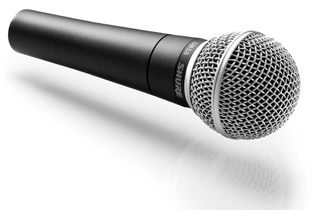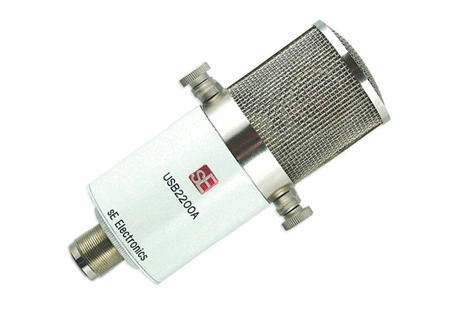Published
Tue, Jun 7, 2011, 14:30
- Need to record vocals but don't know where to begin? Step right up.

Sample libraries and plug-ins are wonderful things and there's such a diversity of titles on the market these days that almost all sonic bases are covered. This includes vocal content, of course, though even the most comprehensive phrase libraries available are still that: a set of stock phrases which will never fully convey the range of emotions you're looking for in your own tracks.
Sooner or later, almost all producers realize that the only way they'll get the vocal content they want is to invest in a microphone. However, with so much choice available and costs ranging from low to astronomically high, it can be tricky to work out which microphone type is best for your needs. So, this week, we'll outline the considerations you need to work through before parting with your money.
Before shopping, it's worth looking at the other kit in your setup, as it's possible that you'll need to add additional items to your wish-list. If you're using the internal soundcard of your laptop to provide audio playback, you've got to decide how to turn a microphone signal into one which will connect to your computer. So, an external audio interface, complete with microphone inputs, might be an essential additional purchase. Alternatively, you might already have a microphone pre-amp to allow you to set levels up appropriately, which might even contain some EQ and/or compression, in which case your microphone choice might change again.
So, dealing with the requirements of those working on laptops who desire a zero fuss solution, good options are provided by microphones such as SE Electronics' USB2200a and Samson's G Track microphones. These record and convert their signals direct to USB while providing playback monitoring through a headphone port built-in to the microphone itself. These cost-effective solutions remove the need for an audio interface and a channel strip altogether, though there are limitations, most notably in their monitoring capabilities.
 The next consideration is whether you're looking for a microphone simply to handle studio duties, or whether this is a microphone you're also looking to take on stage. Most microphones are either condenser or dynamic models, with the former originally designed for high-quality studio sound and the latter tailored to live performance. With the twin marches of time and progress, both microphone types have become more flexible and cheaper too. Whereas ten years ago, investment in studio condenser microphones represented a significant outlay, these days models from Rode, AKG, SE Electronics, Sontronics and others are all capable of producing pro results at a fraction of the costs of yesteryear.
When buying a studio condenser, there are some key things to look for. Firstly, does the microphone contain switchable polar patterns? These determine the active areas around the microphone diaphragm and decide where sound will be picked up. Secondly, does the microphone contain bass roll off and/or pad options? Some singers almost whisper, whereas others belt every note, so having the option to reduce gain is useful, while it's also useful to be able to switch out unwanted low frequency content.
Dynamic microphones were initially designed for stage use only but their slightly less focused sound can work wonderfully in the studio. Rumour has it that Bono from U2 records all of his vocals through a low-cost hand-held Shure SM58, which certainly hasn't prevented the band from selling millions of records. These are definitely a good choice if you're looking for a single microphone to cover both studio and live needs and while other models are available, at less than £100, the SM58 may well represent your best choice here.
Beyond the microphone itself, you'll need an appropriate cable, which may or may not be included. If you're going down the studio condenser route, you'll also need a microphone stand as the bodies of condenser microphones will produce noise if handled. A pop shield, to prevent plosive "p" and "b" sounds from causing distortion while recording, is also thoroughly recommended, as is some way of isolating the sound of the room from your recording. SE's Reflexion Filter is available in two forms (and at two prices) and both are great at providing localized acoustic treatment around a microphone to prevent too many reflections from being picked up. Similar ideas have been researched and developed by other manufacturers too, so shop around to seek out the best deals.
The next consideration is whether you're looking for a microphone simply to handle studio duties, or whether this is a microphone you're also looking to take on stage. Most microphones are either condenser or dynamic models, with the former originally designed for high-quality studio sound and the latter tailored to live performance. With the twin marches of time and progress, both microphone types have become more flexible and cheaper too. Whereas ten years ago, investment in studio condenser microphones represented a significant outlay, these days models from Rode, AKG, SE Electronics, Sontronics and others are all capable of producing pro results at a fraction of the costs of yesteryear.
When buying a studio condenser, there are some key things to look for. Firstly, does the microphone contain switchable polar patterns? These determine the active areas around the microphone diaphragm and decide where sound will be picked up. Secondly, does the microphone contain bass roll off and/or pad options? Some singers almost whisper, whereas others belt every note, so having the option to reduce gain is useful, while it's also useful to be able to switch out unwanted low frequency content.
Dynamic microphones were initially designed for stage use only but their slightly less focused sound can work wonderfully in the studio. Rumour has it that Bono from U2 records all of his vocals through a low-cost hand-held Shure SM58, which certainly hasn't prevented the band from selling millions of records. These are definitely a good choice if you're looking for a single microphone to cover both studio and live needs and while other models are available, at less than £100, the SM58 may well represent your best choice here.
Beyond the microphone itself, you'll need an appropriate cable, which may or may not be included. If you're going down the studio condenser route, you'll also need a microphone stand as the bodies of condenser microphones will produce noise if handled. A pop shield, to prevent plosive "p" and "b" sounds from causing distortion while recording, is also thoroughly recommended, as is some way of isolating the sound of the room from your recording. SE's Reflexion Filter is available in two forms (and at two prices) and both are great at providing localized acoustic treatment around a microphone to prevent too many reflections from being picked up. Similar ideas have been researched and developed by other manufacturers too, so shop around to seek out the best deals.
 The next consideration is whether you're looking for a microphone simply to handle studio duties, or whether this is a microphone you're also looking to take on stage. Most microphones are either condenser or dynamic models, with the former originally designed for high-quality studio sound and the latter tailored to live performance. With the twin marches of time and progress, both microphone types have become more flexible and cheaper too. Whereas ten years ago, investment in studio condenser microphones represented a significant outlay, these days models from Rode, AKG, SE Electronics, Sontronics and others are all capable of producing pro results at a fraction of the costs of yesteryear.
When buying a studio condenser, there are some key things to look for. Firstly, does the microphone contain switchable polar patterns? These determine the active areas around the microphone diaphragm and decide where sound will be picked up. Secondly, does the microphone contain bass roll off and/or pad options? Some singers almost whisper, whereas others belt every note, so having the option to reduce gain is useful, while it's also useful to be able to switch out unwanted low frequency content.
Dynamic microphones were initially designed for stage use only but their slightly less focused sound can work wonderfully in the studio. Rumour has it that Bono from U2 records all of his vocals through a low-cost hand-held Shure SM58, which certainly hasn't prevented the band from selling millions of records. These are definitely a good choice if you're looking for a single microphone to cover both studio and live needs and while other models are available, at less than £100, the SM58 may well represent your best choice here.
Beyond the microphone itself, you'll need an appropriate cable, which may or may not be included. If you're going down the studio condenser route, you'll also need a microphone stand as the bodies of condenser microphones will produce noise if handled. A pop shield, to prevent plosive "p" and "b" sounds from causing distortion while recording, is also thoroughly recommended, as is some way of isolating the sound of the room from your recording. SE's Reflexion Filter is available in two forms (and at two prices) and both are great at providing localized acoustic treatment around a microphone to prevent too many reflections from being picked up. Similar ideas have been researched and developed by other manufacturers too, so shop around to seek out the best deals.
The next consideration is whether you're looking for a microphone simply to handle studio duties, or whether this is a microphone you're also looking to take on stage. Most microphones are either condenser or dynamic models, with the former originally designed for high-quality studio sound and the latter tailored to live performance. With the twin marches of time and progress, both microphone types have become more flexible and cheaper too. Whereas ten years ago, investment in studio condenser microphones represented a significant outlay, these days models from Rode, AKG, SE Electronics, Sontronics and others are all capable of producing pro results at a fraction of the costs of yesteryear.
When buying a studio condenser, there are some key things to look for. Firstly, does the microphone contain switchable polar patterns? These determine the active areas around the microphone diaphragm and decide where sound will be picked up. Secondly, does the microphone contain bass roll off and/or pad options? Some singers almost whisper, whereas others belt every note, so having the option to reduce gain is useful, while it's also useful to be able to switch out unwanted low frequency content.
Dynamic microphones were initially designed for stage use only but their slightly less focused sound can work wonderfully in the studio. Rumour has it that Bono from U2 records all of his vocals through a low-cost hand-held Shure SM58, which certainly hasn't prevented the band from selling millions of records. These are definitely a good choice if you're looking for a single microphone to cover both studio and live needs and while other models are available, at less than £100, the SM58 may well represent your best choice here.
Beyond the microphone itself, you'll need an appropriate cable, which may or may not be included. If you're going down the studio condenser route, you'll also need a microphone stand as the bodies of condenser microphones will produce noise if handled. A pop shield, to prevent plosive "p" and "b" sounds from causing distortion while recording, is also thoroughly recommended, as is some way of isolating the sound of the room from your recording. SE's Reflexion Filter is available in two forms (and at two prices) and both are great at providing localized acoustic treatment around a microphone to prevent too many reflections from being picked up. Similar ideas have been researched and developed by other manufacturers too, so shop around to seek out the best deals.